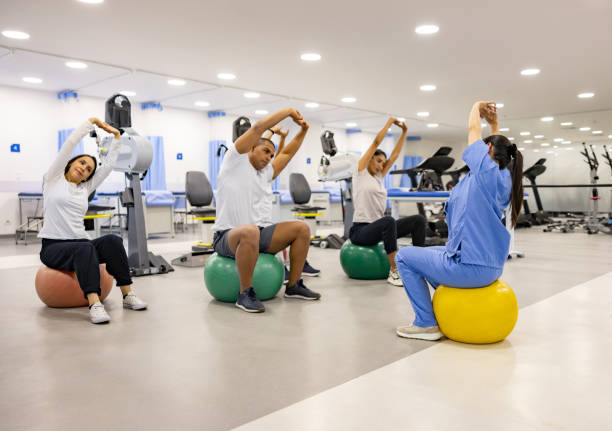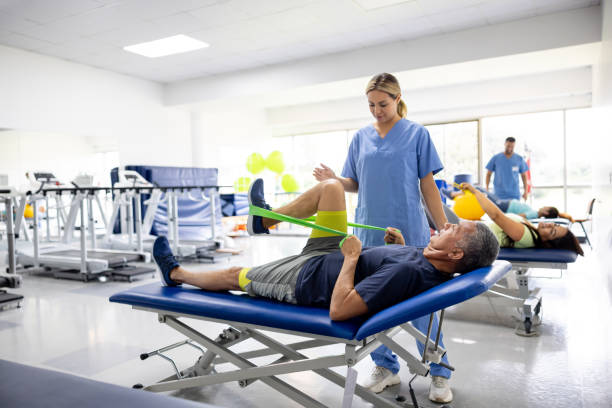Physiotherapy is a safe and effective treatment that is less expensive than multiple trips to the physician, medical exams, and prescription pain killers. It also promotes wellness and overall health.
Physiotherapy involves various manual therapies and exercises for musculoskeletal conditions, including spinal manipulation techniques, soft tissue mobilization, muscle strengthening exercises, and electrotherapy.

Strengthening Exercises
In addition to improving flexibility and reducing pain, muscle-strengthening activities can lower blood pressure and reduce the risk of heart disease, according to Health and Human Services (HHS). These exercises also make it easier to lift heavy objects or perform everyday tasks, such as climbing stairs or reaching overhead.
Strengthening exercises are different than aerobic exercise because they focus on strengthening specific muscles groups rather than the entire body. For example, a pushing exercise such as a push-up recruits the pectoral muscles (chest muscles) and triceps muscles. A pulling exercise, on the other hand, recruits the back and biceps muscles.
Physiotherapists design individualized strength, balance and mobility training programs that can significantly improve an individual’s quality of life. These programs can also help slow the onset of chronic conditions, such as arthritis and fibromyalgia.
Athletes often seek physiotherapy treatment to optimize performance and prevent sports injuries. Physiotherapists use a combination of techniques, including posture correction and movement analysis, to develop tailored training programs and educate athletes on proper body mechanics and injury prevention.
Manual Therapy
Manual therapy is a collection of hands-on techniques that your physical therapist performs on your body. These passive treatments, ranging from kneading to manipulating soft tissue like muscles, can increase flexibility and reduce pain, stiffness and swelling. They are generally done in tandem with more active physiotherapy techniques such as strengthening and balance training, or a combination of both.
Manual treatment techniques include passive mobilization of joints, soft tissue manipulation, muscle energy technique, craniosacral techniques and visceral manipulation. The techniques vary based on the area that is being treated but all aim to produce a threefold effect: biomechanical to improve movement, neurophysiological to modify muscle function and psychological to reduce anxiety.
Your physical therapist may also use elastic taping techniques to relieve pressure from swollen tissue or enhance lymphatic fluid exchange. This can be useful for injured muscles and tendons that have developed scar tissue, causing decreased circulation. These stretching and pressure techniques can loosen the tissues and allow them to heal.
The simplest of these hands-on techniques is soft tissue mobilization or massage. Rhythmic stretching and deep powerful stroking of the muscles can help relax tight muscles, improve circulation, reduce muscle spasm and decrease pain. The therapist can also use passive movement of the joint to increase its range of motion and improve nerve mobility. These types of movements are called joint manipulation.

Electrotherapy
Physiotherapy involves manual treatment methods that stretch, align, and strengthen muscles and joints to alleviate pain and help the body heal. Often these techniques are combined with electrotherapy. These electrical treatments use pulses of electricity to reduce pain, stimulate muscle movement and tissue repair, promote bone growth and increase strength. Electrotherapy modalities include TENS, EMS (Electrical Muscle Stimulation), interferential therapy and ultrasound.
In general, electrical stimulation of painful areas interrupts or blocks the transmission of neural pain signals to the brain. It may also encourage the release of natural painkillers called endorphins. Unlike medications, there are no significant side effects associated with most forms of electrotherapy. However, some people may experience skin irritation from the adhesives or tape used to apply electrode pads. Those with sensitive skin should let their physiotherapist know beforehand if they are concerned about a potential reaction.
The physiotherapist will determine which form of electrotherapy is best for each patient. This is a highly individualized process that takes into account the individual’s specific anatomy and condition. Only experienced physiotherapists are trained to know which modalities to use and when to use them. Electrotherapy is a very useful tool that can help to alleviate pain, accelerate healing and promote movement while preventing further injury.
Lifestyle Changes
Royal Rehab LifeWorks Cairns offers an effective way to address injuries, pain, and chronic conditions, improving strength, mobility, and confidence. It can also prevent future problems by identifying risk factors and developing prevention strategies.
For example, a physiotherapist can develop customised balance training programs for older adults and people at risk of falls, improving stability and proprioception. Physiotherapists can also educate individuals on proper posture and ergonomics, optimising health in the workplace or during physical activities to minimise injury risks.
Physiotherapy Rehab Cairns can also improve lung function for those with chronic diseases like COPD or asthma, and offer breathing exercises to enhance pulmonary rehabilitation. And physiotherapists can use their expertise to rehabilitate patients with neurological conditions such as stroke, multiple sclerosis or traumatic brain injury, restoring motor functions and helping to achieve independent living.
While intensive lifestyle change won’t work if it’s ordered by a doctor, it can be an essential part of physiotherapy, especially if the physician acts as a coach to encourage and support patients without judgment. Patients can make healthy changes such as eating a plant-based diet, exercising daily, reducing stress, getting restorative sleep and cultivating positive social connections to boost their overall wellbeing. Those who commit to implementing these changes will see the fastest results.

 October 13th, 2023
October 13th, 2023  adminva2
adminva2  Posted in
Posted in